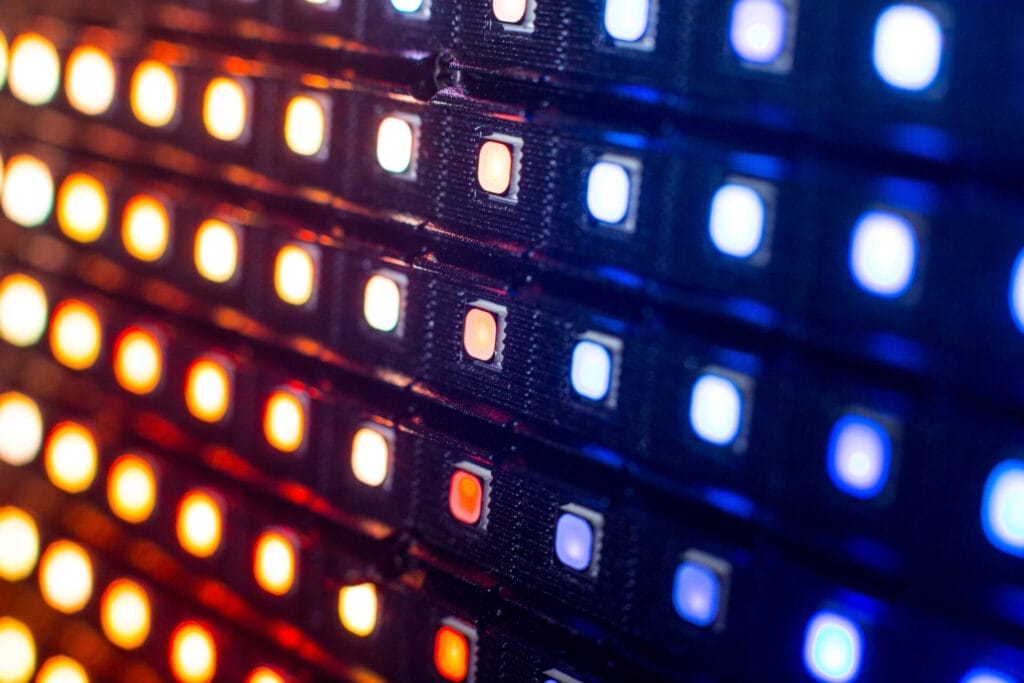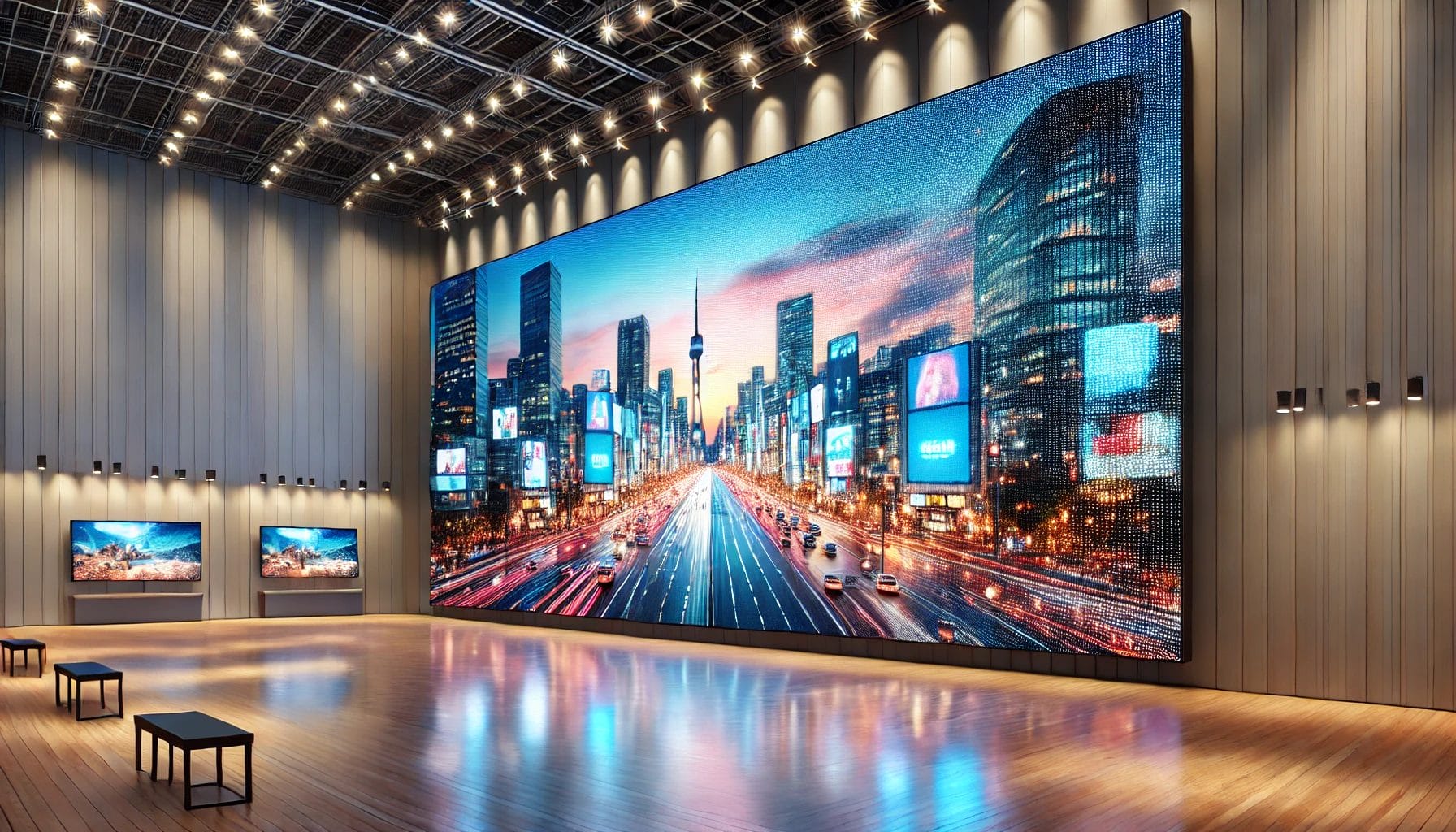LED displays: the modern-day beacons of visual communication. But what sets apart the dazzling screens indoors from their robust outdoor counterparts?
In this post, we’ll dive in and take a closer look at indoor vs outdoor LED displays. From lightweight architecture, to a fine pixel pitch and weather-proof exteriors, we’ll uncover the true differences between the two. By the end of this post, you’ll have a true understanding to decide which you’ll want to explore further.
Ready to decode the brilliance? Let’s dive in.
What is an LED Display?
Trying to define the purpose of an LED display can feel somewhat impossible — it’s versatility in use across so many different industries, mediums and applications make it one of the most flexible pieces of technology today.
LED Scoreboards
New! LED Scoreboard Packages from Firefly LED
In the end, though, we can come to the conclusion that an LED display, whether indoor or outdoor, is a visual digital display technology that uses many LEDs to produce brilliant content often for marketing purposes.
An LED display is often made of several individual LED panels, seamlessly put together to create a larger screen. All of the individual pixels work together to generate your content, with varying sizes, resolutions, and capabilities possible.
Technical Specifications
Now, as we briefly alluded to, an LED display can come in many different sizes, resolutions, materials, and so much more. So let’s take a look at some of the technical specifications and differences between the indoor and outdoor LED display.
Pixel Pitch
A pixel pitch is defined as the space between the individual pixels on the LED panel. A smaller pixel pitch will indicate that the pixels are very close together, thus creating a higher resolution image. And on the contrary, a larger pixel pitch means the pixels are farther apart, and produce a lower resolution image.
Pixel pitch plays a huge role in exploring the indoor vs outdoor LED displays conversation — this is determined by the viewing distance. Let’s explain:
- Indoor LED displays: As it pertains to indoor displays, you will often find they are small-to-medium pixel pitches. This is due to the likelihood that an indoor LED display is viewed at a closer distance, and needing a higher resolution display. You’ll find a common range will be in the 2-4 mm pixel pitch, however with a fine pixel pitch display you can get as low as 0.9 mm.
- Outdoor LED displays: With outdoor displays, you most often see them used in larger sizes and capacities, and viewed at much farther distances, thus you don’t need as small of a pixel pitch. Pixel pitches of an outdoor LED display range in the 5 to 10 mm, however you still can find higher resolution options from 1.5 to 4 mm.

Brightness & Contrast
When comparing brightness and contrast in indoor vs outdoor LED displays, there are distinct considerations due to the varying environments they are designed for:
- Indoor LED displays: With an indoor environment, you often have controlled lighting that doesn’t cause any competing light issues. As a result, you will see that an indoor display can get away with much lower brightness, but experience deeper, richer blacks and vibrancy as it pertains to contrast.
- Outdoor LED displays: Outdoors are much different when it comes to brightness and contrast — due to the sunlight, you’ll need a significant amount of brightness to combat it and make your visuals stand out. Because of the need for high brightness, it can be more difficult to obtain a deep contrast.
Durability & Construction
Another specification to explore in the indoor vs outdoor LED display comparison is the durability and construction of the panels.
- Indoor LED displays: As we touched on in the brightness and contrast category, an indoor display is in a more controlled environment — therefore, you often don’t need as rugged of a display. Don’t let that fool you, though, because take a look at the architecture of an indoor LED display and you’ll discover some of the most high-quality components and technology involved in LED.
- Outdoor LED displays: On the contrary, the durability and ruggedness required for an outdoor display is critical. Think rain, snow, direct sunlight, wind, and so many more environmental elements. Due to these conditions, you’ll find protective armor coatings and high IP ratings for the best protection possible. Components and casings are sealed and can feature materials resistant to corrosion and advanced technology for heat dissipation.
Viewing Angles & Content Visibility
Now that we’ve covered some of the most important technical specs, lets dive into some additional details. Another important piece to the indoor vs outdoor LED display puzzle is talking about the visibility.
Every LED panel has ideal viewing angles for best visibility of the content. You might find that in an indoor LED display, you can get away with a smaller viewing angle, whereas an outdoor display you’d need a larger, wider viewing angle.
This is all dependent, of course, on the actual application — for example, if you’ve got a large indoor LED display in a restaurant bar, displaying sports games for customers, you may need a wider angle for viewing so that those on the side of the bar can still see the content.
In addition to viewing angles, there are some differences that you’ll notice in terms of content visibility. In the end, you’re utilizing an LED display to reach an audience — no matter if you’re indoors or outdoors. In order to achieve this, you must create content with the most impact.
So for an indoor display, take advantage of the high resolution and feature intricate details and vivid colors to really capture passersby. In an outdoor display, make sure your text is visible from the optimal distance — too small of fonts and your messaging will be missed. So go big, go bold, and don’t worry about the intricate details.
Cost & Maintenance
Probably the most sought after portion of this indoor vs outdoor LED display comparison, cost and maintenance can play a huge role in how you move forward. Of course, you may not have an option depending on your use, but we’re assuming you want to understand the differences upon reading this article.
Keep in mind: the cost of an LED display can vary greatly depending on the LED provider you choose to go with. Just like any other product you buy, price does not always dictate the quality, and you should do your due diligence on the provider to ensure you’re getting an LED display that suits your needs.
Now, generally speaking, you will find that on average an indoor display can be a lower initial investment than an outdoor display. This is due to the additional environmental features required in an outdoor display. Additionally, you’ll find that an outdoor display may draw more power because of the high brightness required over the counterpart display. With advancements in technology, though, an improved energy-efficiency in how the display is manufactured can help with ongoing energy costs greatly.
Ongoing maintenance for both indoor and outdoor video screens are not intensive. This is the beauty of LED displays in general, as they do not require much attention. You may find that an outdoor display, depending on your environment and how harsh the conditions may be, will need some upkeep in maintaining the visibility at its optimal peak.

Trends & Innovation
Trends and innovations in the realm of LED displays continually shape the capabilities and possibilities for both indoor and outdoor implementations.
Believe it or not, as great as LED displays have always been, they only keep getting better! advancements in pixel pitches have propelled the use of LED displays in more immersive applications. You’ll find immersive LED displays on movie sets for XR and film production, which is helping cut production costs immensely.
When it comes to artificial technology and interactivity, LED displays are being used for further content optimization and engagement. Real-time updates, conditional content, and touch-screens are all part of the possibilities in the advancements and future of LED displays.
Additionally, with an expanded technological advancement in LED, you’ll find more options in the flexible LED panel space — elevating creativity and unique experiences beyond imaginable.
The Best Indoor & Outdoor LED Displays
Here at Firefly LED, we believe in providing the most high-quality LED displays possible, at the most affordable prices for you. We have a full lineup of indoor and outdoor LED displays, with these being our true standouts:
A Series
Our elite indoor LED panel, the A Series features the latest and greatest innovations. Coming in at a fine pixel pitch as low as 0.9 mm, the resolution of this indoor LED display is second to none.
Flyer Series
A standalone LED panel, excellent for retail, is our Flyer Series. This LED display has the option to mount on wheels, so you can move it around your store as needed, and provide compelling graphics to capture more customers.
OHB Series
Our top-of-the-line outdoor display, the OHB Series is a high-resolution LED panel with a high-strength aluminum structure to combat the toughest of environments, all while providing a beautiful picture.
Navigating Indoor vs Outdoor LED Displays
In the realm of LED displays, the choice between indoor and outdoor isn’t really a battle — but a decision defined by unique environments and distinct requirements.
- Indoor LED displays: Rich in detail and color, indoor LED displays excel in controlled settings, captivating close-up audiences with vibrant visuals and immersive experiences.
- Outdoor LED displays: Enduring the elements, outdoor displays command attention from afar, sacrificing detail for visibility, yet delivering bold, captivating visuals.
Each type of LED has their purpose, and if you’re unsure about which display will help you get the best return on your investment, our team of professionals are available to help.
The advantages of LED displays bring true excitement, and we’re glad you’re on the journey to start creating.





